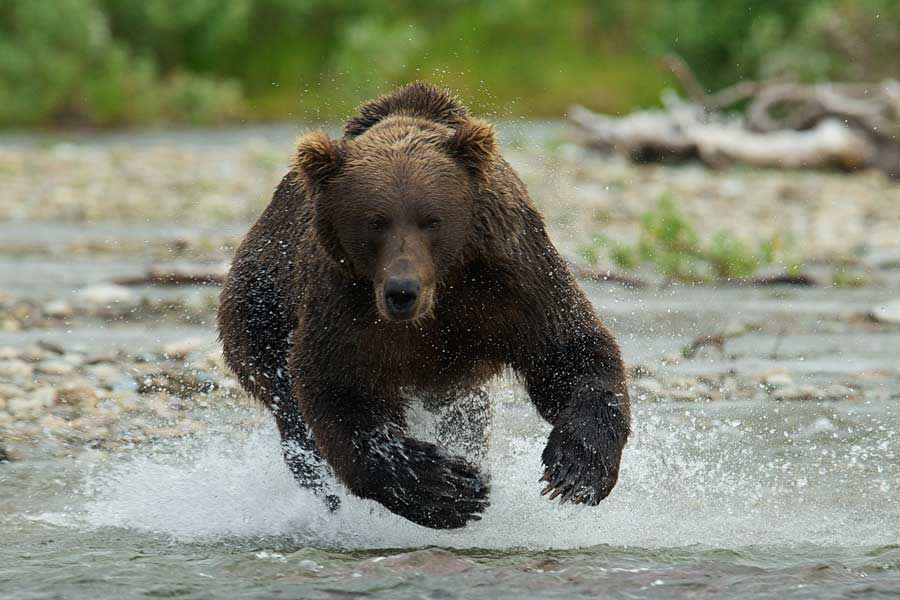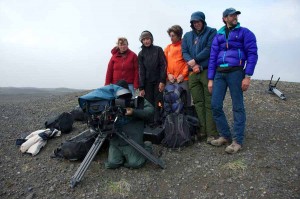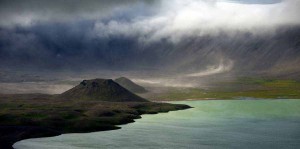
A coastal brown bear charges toward the camera in a still from The Ends of the Earth, an in-progress film about the Aniakchak National Monument and Preserve in Alaska. The film is among those to be screened Sept. 13-15 at the Second Annual Grand Teton National Park Film Festival. (Photo courtesy of Roy W. Wood - click to enlarge)
From Staff Reports
Grand Teton National Park will host a special three-day film festival Sept. 13-15 featuring an eclectic collection of works highlighting wildlife, scenic places and the great outdoors.
The second annual Grand Teton National Park Film Festival will be held at the Craig Thomas Discovery and Visitor Center in Moose, Wyo., according to a statement released by the Grand Teton public affairs office. Modeled after similar events like the Telluride and Banff film festivals, the festival is made possible through funding by the Grand Teton National Park Foundation with the help of local corporate sponsors. All screenings are free, with seating available on a first-come, first-served basis.

Filmmakers form a "human windbreak" for a cameraman while shooting in Alaska's Aniakchak National Monument and Preserve. (Photo courtesy of Roy W. Wood - click to enlarge)
This year’s films all explore the human experience in the natural world and profile remarkable natural landscapes.
U.S. Fish and Wildlife Service historian Mark Madison and John Grabowska, a National Park Service producer and environmental filmmaker, served as curators for the selections, many of which were created using high-definition cameras.
All films will be shown in the Discovery Center’s 150-seat auditorium on a large-format screen with state-of-the-art projector and sound system.
The Grand Teton Film Festival schedule includes:
Thursday, Sept. 13
7 p.m. — Nanook of the North (78 min)
One of the most famous films ever made, this groundbreaking silent movie from 1922 follows the lives of an Inuit man and his family as they travel, search for food, and trade in northern Quebec. Nanook and Nyla, his wife, plus their baby, Cunayou, are introduced as fearless heroes who endure rigors “no other race” could survive. This seminal documentary is presented by environmental historian Mark Madison.
Friday, Sept. 14
7 p.m. — Mi Chacra (My Land) (100 min)
Beautifully photographed, this film depicts a year in the life of a rural Peruvian indigenous farmer and Inca porter who wants a better life for his son in the city. Produced by a recent graduate of the Montana State University master’s program in Science and Natural History Filmmaking, this film with English subtitles earned Grand Prize at the Banff Mountain Film Festival.
8:45 p.m. — Remembered Earth (28 min)
Filmmaker John Grabowska presents a stunning and sobering portrait of New Mexico’s high desert, a “National Sacrifice Area” to the nation’s energy appetite. Author N. Scott Momaday, the first American Indian to win the Pulitzer Prize for literature, interprets the myth, beauty and power of this scarred but sacred landscape. The Washington Post called it “Poetic, irreverent and ingenious.”
Saturday morning, Sept. 15
10 a.m. — Chasing Water (18 min)
Travel the Colorado River with Murie Center advisor Jon Waterman, who became the first to paddle the entire length of the river from its headwaters to the Sea of Cortez with an intimate look at the watershed. Photographer Pete McBride teamed up with his bush pilot father to capture an artistic, aerial view of this national treasure.
Fish and Cow (15 min)
High, cold and remote, the Big Hole Valley of Montana is home to one of the last surviving populations of a unique and sensitive species of fish: the fluvial Arctic grayling. This film is a story about a group of dedicated ranchers and biologists who find common ground, not only to try to save this fish, but also to preserve the ecological health of the Big Hole Valley itself.
Refuge of the American Spirit: Theodore Roosevelt National Park (26 min)
Photographed by Jackson cinematographer Jeff Hogan, this film takes an intimate look at the badlands of western North Dakota and the conservation president who was influenced by this stern and unforgiving land.
Saturday afternoon, Sept. 15

Clouds form over Alaska's Aniakchak National Monument and Preserve, the least-visited National Park Service unit. (Photo courtesy of Roy W. Wood - click to enlarge)
1 p.m. — People of a Feather (90 min)
This film portrays the world of Inuit on the Belcher Islands in Hudson Bay through a 21st century Nanook of the North story. It connects past, present and future into a unique cultural relationship with the eider duck. Eider down, the warmest feather in the world, allows both Inuit and bird to survive harsh Arctic winters.
Tokyo Waka (63 min)
Tokyo’s digital metropolis is layered with people day and night. More than 20,000 crows perch on power lines and buildings above the city streets. As their numbers soared in recent years, Tokyo fought back by trapping crows, destroying nests, and securing trash. Among the smartest of animals, the crows adapted. Now 13 million Japanese people live alongside the crows in an uneasy stalemate.
4 p.m. — Woman Among Wolves (46 min)
Extreme athlete and field biologist Gudrun Pflueger studied the elusive coastal wolves of British Columbia and credits the experience with helping her survive cancer. “I really believe the encounter with the wolves in the wilderness was a powerful medication. They gave me strength,” said Pflueger.
Triumph and Tragedy on the Little Bighorn (24 min)
Featuring compelling reenactments mixed with interviews of descendants, Triumph and Tragedy breaks down the complexities of an iconic Western story: the seminal battle of American expansionism and the Great Sioux War of 1876-77.
Saturday evening, Sept. 15
7 p.m.—American Cougar (45 min)
Jackson filmmaker Jeff Hogan presents a story of cougars surviving in the rugged Northern Rockies landscape. A determined team of researchers mounts grueling expeditions in an effort to gain scientific data. Cougar F51, a young crafty female, is tested as she struggles to give birth to a healthy litter of kittens after enduring a severe winter.
8:30 p.m.—The Ends of the Earth (60 min)
The breathtaking volcanic landscape of the Alaska Peninsula is home to the greatest concentration of coastal brown bears. Bruins are drawn to the largest sockeye salmon run in the world. A work-in-progress film.
National Park Service filmmaker John Grabowska has directed productions from the subarctic to subtropics. Often broadcast as prime time specials on PBS, his films have also won awards at festivals around the world. Grabowska led environmental media workshops in Argentina and Panama and has served as a guest lecturer at the Smithsonian Institution and National Geographic Society. He co-founded the American Conservation Film Festival and is currently completing a PBS film on the Alaska Peninsula. The Washington Post calls him “one of the virtuoso environmental filmmakers in the country.”
Mark Madison earned degrees in biology and history and received a Ph.D. in the history of science from Harvard University. He taught environmental history, American history, environmental ethics, and conservation biology at Harvard, the University of Melbourne, and Shepherd University, and is currently the national historian for the U.S. Fish and Wildlife Service. He lectures on conservation issues around the country and runs the conservation archives at the National Conservation Training Center. He has two books in progress: one on wolf restoration and another on the California condor.
